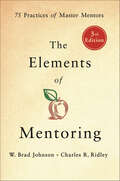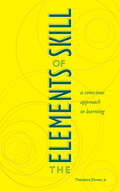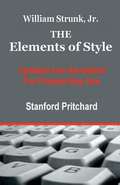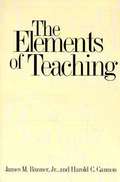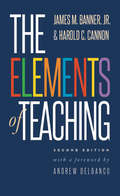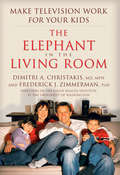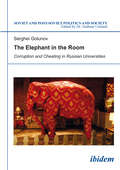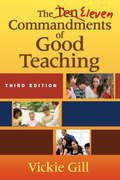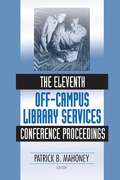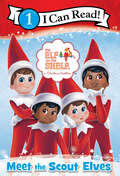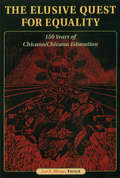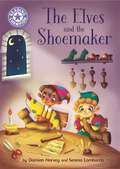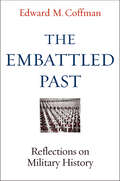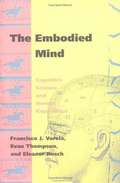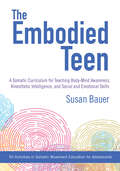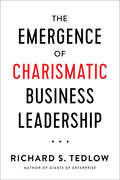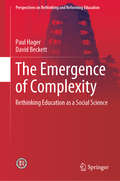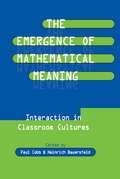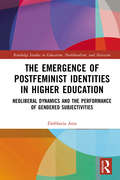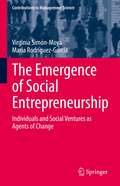- Table View
- List View
The Elements of Mentoring: 75 Practices of Master Mentors
by Charles R. Ridley W. Brad JohnsonPatterned after Strunk and White's classic The Elements of Style, this new edition concisely summarizes the substantial existing research on the art and science of mentoring. The Elements of Mentoring reduces this wealth of published material on the topic to the sixty-five most important and pithy truths for supervisors in all fields. These explore what excellent mentors do, what makes an excellent mentor, how to set up a successful mentor-protégé relationship, how to work through problems that develop between mentor and protégé, what it means to mentor with integrity, and how to end the relationship when it has run its course. Succinct and comprehensive, this is a must-have for any mentor or mentor-to-be.
The Elements of Skill
by Larry A. Hickman Theodore DimonWhy do so many beginners, both children and adults, fail to master chosen skills? The Elements of Skill was inspired by--and addresses--that question with a program based on proven techniques. The book, written by a renowned practitioner of the Alexander Technique, outlines an educational system that makes the process of learning a performance or athletic skill more conscious, and therefore more successful. Its principles include breaking down a skill into manageable parts, setting realistic goals, observing mind/body processes, overcoming blocks, controlling habits, and achieving heightened awareness and self-mastery. Included are inspiring examples of people who have benefited from the method.
The Elements of Style: Updated and Annotated for Present-Day Use
by William Strunk Stanford PritchardThe book was revised and expanded by E. B. White, of New Yorker fame, in 1959, but it has had no significant update since 1979. And since that time, many little affronts (for some of us, insults) to the eye and ear have gotten into the language. So here is a new edition of Strunk's classic work, with many of his rules and pronouncements expanded and explained; with new sections on proper usage and correct spelling; and even a "Rogue's Gallery" comprised of samples of egregious writing culled from current newspapers and magazines. For anyone who will reflect on it, language is an ongoing, fascinating adventure. The author intends this book to make that adventure more rewarding, and more enjoyable. Oh. The difference between "dryer" and "drier"? That, like so much else, is in the book.
The Elements of Teaching
by Harold C. Cannon James M. Banner Jr.This book focuses on the qualities, both natural and cultivated, of those who teach rather than on the techniques they use because far too much attention has been given to explaining the process of teaching and not nearly enough to describing the people responsible for that process.
The Elements of Teaching: Second Edition
by James M. Banner Andrew Delbanco Harold C. CannonA newly revised edition of this classic work, exploring the diverse qualities essential for teaching in today’s educational environment. According to Banner and Cannon, to be an effective teacher requires much more than technical skill. Great teaching is an art that combines a wide range of intellectual, moral, and emotional components. This classic work explores the qualities of mind and spirit that are essential for those seeking to help others acquire knowledge and understanding. It analyzes the specific qualities of successful teachers: learning, authority, ethics, order, imagination, tenacity, compassion, patience, character, and pleasure. Written in a clear and engaging style and applicable to all levels of teaching—be it in schools and universities or on athletic fields and in the home—the book encourages teachers to consider how they might enlarge their understanding of the great art of teaching.
The Elephant In The Living Room: Make Television Work for Your Kids
by Dimitri A. Christakis Federick J. ZimmermanThe nation's top child development experts examine the effects of television on children and their groundbreaking research will startle manyTelevision is the "elephant in the living room" of our culture. American children watch television an average of 3 hours per day, and many parents sheepishly concede that they rely on television as an electronic babysitter. But TV is not necessarily harmful to kids. The authors present groundbreaking scientific evidence that television can be a powerful and effective tool—for entertainment, for education, and for socialization. The secret is for parents to learn how to use television as a tool, not a crutch. With a detailed explanation of the effects of television viewing on kids' emotional, mental, and physical development, plus tips to enable parents to act on this new knowledge, they'll soon be able to turn TV into a positive force in their child's life. The authors share:• which popular shows increase your child's reading ability—and which may delay speech development• which televised sports boost girls' self-image—and which ones could cause eating disorders• the best and worst programming for every age, from toddler to teen
The Elephant in the Room: Corruption and Cheating in Russian Universities (Soviet and Post-Soviet Politics and Society #132)
by Serghei GolunovThis book offers a long overdue account of the vast corruption and cheating practices in Russian higher education, including bribery, financial fraud, clientelism, plagiarism, and exam cheating. Serghei Golunov ruthlessly uncovers the recent social trends that have created a favorable ground for such malpractices and evaluates the efficiency of measures taken against corruption and fraud by various actors. Although corruption and cheating are so widespread the value of most Russian diplomas is in doubt, these problems are prioritized neither by higher education managers nor by foreign actors such as partner universities, participants of the Bologna process, or the authors of global university rankings.
The Elephant in the Staffroom: How to reduce stress and improve teacher wellbeing
by Chris EyreThe Elephant in the Staffroom is the survival guide that every busy teacher needs for practical advice on teacher wellbeing. Written in an informal, conversational style, the book is divided into 40 bite-size chunks, covering a range of essential topics from understanding and avoiding burnout, to successful working patterns, and even surviving the school holidays! Complemented by a host of top tips, the book focuses on five key themes: the psychology of the teacher teacher identity emotional and physical energy keeping focused and investing in yourself colleagues, students and inspection Chapters are designed to be easily dipped in and out of, with each exploring the unique nature of the teaching profession and how to cope with, and conquer, a variety of stress triggers and psychological aspects of teaching – ‘elephants’ in the staffroom – to survive and succeed. Written by a head of department with over twenty years of classroom experience, this essential guide offers a wealth of practical advice on stress, work-life balance and organisation, and is a must-read for practising teachers.
The Eleven Commandments of Good Teaching
by Vickie GillWith new material on classroom technology, evolving social climates, limited budgets, and standardized testing, this inspirational resource provides wisdom and advice for staying committed to excellence.
The Eleventh Off-Campus Library Services Conference Proceedings
by Patrick MahoneyLearn how to provide better service to distance information users! This book is the result of the conference held in May, 2004 in Scottsdale, Arizona, focusing on librarians' challenges providing service to nontraditional faculty and students. Respected authorities discuss in detail specific problems-and fresh strategies and solutions-to further promote service to distance information users. Each chapter tackles a particular issue such as collaboration outside the contributor's organization or how services can be monitored and assessed to gauge quality, and fully explains what can be done to address those issues. Each distinguished contribution was carefully selected by a 26-member advisory board using a juried abstracts process. Thorough bibliographies, useful figures, tables, and graphs provide accessibility and clarify ideas. Some of the topics in this book include: the promotion of library services to Native American students the planning and development process of a project to create a Web-based multi-media instruction tool for off-campus graduate students an examination of direct linking tools provided by major aggregators distance learning for the learning disabled distance learning implementation strategies for institutions course management software (CMS) and library services integration a survey of Association of Research Libraries offered services the do&’s and don&’ts of videoconferencing on and off-campus an eBooks collection study one-on-one research coaching via digital reference service an online tool that assesses students&’ research skills and attitudes creating a library CD for off-campus students expanding student and faculty access to information services the collaboration with faculty on electronic course reserves developing assessment questions for services supporting off-campus learning programs providing secure off-campus access to library services beyond proxy servers and much, much more!The Eleventh Off-Campus Library Services Conference Proceedings is an invaluable comprehensive resource detailing the latest challenges and solutions for on- and off-campus librarians.
The Elf on the Shelf: Meet the Scout Elves (I Can Read Level 1)
by Alexandra WestDiscover new and old friends as you take a tour around the North Pole, meet the special Scout Elves, and learn about everything they do!A beloved part of family traditions across the world, Elf on the Shelf is among the top three most-recognized holiday character in the US, along with Rudolph and Santa Claus himself. With almost 25 million sales around the world, a float in the Macy’s Day Parade, and the fourth-bestselling holiday title, Elf on the Shelf is a seasonal staple at retail!This book is a Level One I Can Read, perfect for children learning to sound out words and sentences. Whether shared at home or in a classroom, the short sentences, familiar words, and simple concepts of Level One books support success for children eager to start reading on their own.
The Elf on the Shelf: Welcome to the North Pole (I Can Read Level 1)
by Chanda A. BellExplore the magical realm of the North Pole alongside your favorite Scout Elf crew!Readers will delight in meeting not only charming animal friends but also Santa Claus himself! Discover the wonder of the North Pole while uncovering the traditions and adventures that define this extraordinary place in this Level One early reader.This book is a Level One I Can Read, perfect for children learning to sound out words and sentences. Whether shared at home or in a classroom, the short sentences, familiar words, and simple concepts of Level One books support success for children eager to start reading on their own.
The Elusive Quest for Equality: 150 Years of Chicano/Chicana Education
by José F. MorenoThe Elusive Quest for Equality documents both the plight and the struggle of Chicano communities over the past 150 years, using the guiding themes of segregation, Americanization, and resistance in the history of education for Chicanos/Chicanas. The history of the Chicano community's quest for educational equality is long and rich. Since the Treaty of Guadalupe Hidalgo formalized the conquest of half of Mexico's territory into what is now the U.S. Southwest, Chicanos have fought to claim what was promised them in the Treaty--the enjoyment of all the rights of U.S. citizens. In terms of education, they certainly have never had equal access, opportunity, or resources, despite legal victories. In this volume, some of the leading scholars analyze why the quest for equality in education has remained so elusive. They do so by documenting both the plight and the struggle of Chicano communities over the past 150 years, using the guiding themes of the role of language, segregation, Americanization, and resistance in the history of education for Chicanos/Chicanas. "In the cover painting of this book, Manuel Hernandez Trujillo captures...the dualistic nature of the U.S. conquest of Northern Mexico, reflecting both the losses and opportunities represented in his camino de espinas (road of thorns). This tension between cynicism and optimism pervades the essays in this volume...something I see over and over again in discussions that focus on the significance of race in a democratic society. To what extent does the past determine our future, and to what degree do our own expectations of the future influence our interpretations of the past? It seems to me that these two interdependent questions continue to shape both our experience as Chicanos/Chicanas and our understanding of what it means to be Chicano/Chicana in the United States at the end of the twentieth century."Manuel N. Gómez, Vice Chancellor, Student Services, University of California, Irvine, from the Foreword
The Elusive Quest for Equality: 150 Years of Chicano/Chicana Education (HER Reprint Series)
by Jose F. MorenoThe Elusive Quest for Equality documents both the plight and the struggle of Chicano communities over the past 150 years, using the guiding themes of segregation, Americanization, and resistance in the history of education for Chicanos/Chicanas. The history of the Chicano community's quest for educational equality is long and rich. Since the Treaty of Guadalupe Hidalgo formalized the conquest of half of Mexico's territory into what is now the U.S. Southwest, Chicanos have fought to claim what was promised them in the Treaty—the enjoyment of all the rights of U.S. citizens. In terms of education, they certainly have never had equal access, opportunity, or resources, despite legal victories. In this volume, some of the leading scholars analyze why the quest for equality in education has remained so elusive. They do so by documenting both the plight and the struggle of Chicano communities over the past 150 years, using the guiding themes of the role of language, segregation, Americanization, and resistance in the history of education for Chicanos/Chicanas. "In the cover painting of this book, Manuel Hernandez Trujillo captures...the dualistic nature of the U.S. conquest of Northern Mexico, reflecting both the losses and opportunities represented in his camino de espinas (road of thorns). This tension between cynicism and optimism pervades the essays in this volume...something I see over and over again in discussions that focus on the significance of race in a democratic society. To what extent does the past determine our future, and to what degree do our own expectations of the future influence our interpretations of the past? It seems to me that these two interdependent questions continue to shape both our experience as Chicanos/Chicanas and our understanding of what it means to be Chicano/Chicana in the United States at the end of the twentieth century."Manuel N. Gómez, Vice Chancellor, Student Services, University of California, Irvine, from the Foreword
The Elves and the Shoe Shop: Independent Reading Purple 8 (Reading Champion #517)
by Katie WoolleyThis story is part of Reading Champion, a series carefully linked to book bands to encourage independent reading skills, developed with Dr Sue Bodman and Glen Franklin of UCL Institute of Education (IOE) Fantastic, original stories are accompanied by engaging artwork and a reading activity. Each book has been carefully graded so that it can be matched to a child's reading ability, encouraging reading for pleasure. Perfect for 5-7 year olds.
The Elves and the Shoemaker: Independent Reading Purple 8 (Reading Champion #1076)
by Damian HarveyThis story is part of Reading Champion, a series carefully linked to book bands to encourage independent reading skills, developed with Dr Sue Bodman and Glen Franklin of UCL Institute of Education (IOE)Reading Champion offers independent reading books for children to practise and reinforce their developing reading skills.Fantastic, original stories are accompanied by engaging artwork and a reading activity. Each book has been carefully graded so that it can be matched to a child's reading ability, encouraging reading for pleasure. Perfect for 5-7 year olds or those reading book band orange.
The Embattled Past: Reflections on Military History
by Edward M. CoffmanInternationally recognized for having reinvigorated and redefined his field, distinguished military historian Edward M. Coffman is a dedicated and much-admired teacher and mentor. In The Embattled Past, several of his most important essays have been assem
The Embodied Mind: Cognitive Science and Human Experience
by Evan Thompson Francisco J. Varela Eleanor RoschThe Embodied Mind provides a unique, sophisticated treatment of the spontaneous and reflective dimension of human experience. The authors argue that only by having a sense of common ground between mind in Science and mind in experience can our understanding of cognition be more complete. Toward that end, they develop a dialogue between cognitive science and Buddhist meditative psychology and situate it in relation to other traditions such as phenomenology and psychoanalysis.
The Embodied Teen: A Somatic Curriculum for Teaching Body-Mind Awareness, Kinesthetic Intelligence, and Social and Emotional Skills--50 Activities in Somatic Movement Education
by Susan BauerThe first book to offer a somatic movement education curriculum adapted to the needs and sensitivities of adolescentsSusan Bauer presents a groundbreaking curriculum for teaching teens how to integrate body and mind, enhance kinesthetic intelligence, and develop the inner resilience they need to thrive, now and into adulthood. Designed for educators, therapists, counselors, and movement practitioners, The Embodied Teen presents a pioneering introductory, student-centered program in somatic movement education. Using the student's own body as the lab through which to learn self-care, injury prevention, body awareness, and emotional resilience, Bauer teaches basic embodiment practices that establish the foundation for further skill development in sports, dance, and leisure activities. Students learn the basics of anatomy and physiology, and unlearn self-defeating habits that impact body image and self-esteem. By examining their cultural perceptions, they discover their body prejudices, helping them to both respect diversity and gain compassion for themselves and others. Concise and accessible, the lessons presented in this book will empower teens as they navigate the volatile physical and emotional challenges they face during this vibrant, powerful stage of life.
The Emergence of Charismatic Business Leadership
by Richard S. TedlowThe author of Giants of Enterprise examines the evolving role of business leaders in the 21st century—with essential lessons from today&’s trailblazers. In The Emergence of Charismatic Business Leadership, Harvard Business School Emeritus professor Richard S. Tedlow reveals how a handful of individuals have transformed modern-day leadership, making charisma essential to the role. He looks at leaders like Oprah Winfrey, Elon Musk, and Steve Jobs: three pioneers who found success by innovating their management style and using their charisma to champion their vision. Through Tedlow&’s in-depth accounts of modern business history, we see how former outsiders attain power and influence, and how charismatic leadership enables the creation of revolutionary products like the battery electric vehicle and the smart phone. But Tedlow also considers the careers of people who used their charisma to mislead, such as Jeff Skilling of Enron and Elizabeth Holmes of Theranos. In this thorough examination, Tedlow shows how charisma, when combined with genuine character, can get you far.
The Emergence of Complexity: Rethinking Education as a Social Science (Perspectives on Rethinking and Reforming Education)
by Paul Hager David BeckettThis book centres on a broadened view of complexity that will enrich engagement with complexity in the social sciences. The key idea is to employ complexity theory to develop a holistic account of practice, agency and expertise. In doing so, the book acknowledges and builds upon the relational character of reductive accounts. It draws upon recent theoretical work on complexity, emergence and relationality to develop a novel account of practice, agency and expertise in and for workplaces. Biological, psychological and social aspects of these are integrated. This novel account overcomes problems in current views of practice, agency and expertise, which suffer from reductive, or fragmented, analyses, based upon individuals, groups, or networks. In retrieving the experiential richness of human activity – often esteemed as the basis of generative and creative life – this book shows how complexity both emerges from, and is, a non-reductive feature of, human experience, especially in daily work.“…an ambitiously wide-ranging volume, questioning the key tenets of respected approaches ….. and offering ….. ‘novel accounts’, which draw on features of complexity thinking…. …But they go further than any of us in their argument that: ‘whatever reductive moves are made, they ‘flow’ from holistic accounts of relationality which have already affectively engaged the purposes of a co-present group.’ This is the intellectual contribution that is built consistently and persuasively across the chapters.” Professor Emerita Anne Edwards, Oxford University"Hager and Beckett have written a book that will challenge more commonly held notions of agency, practice, skills, and learning. Centering their argument on complexity theory or, as they prefer, complexity thinking, Hager and Beckett argue that it is through relations that we raise questions about, gather data from, and make working sense of the complexity that surrounds us. Groups then, particularly small groups, hold and implement agentive power. And what the authors call co-present groups—ones in which holistic relationality occurs socially, and affectively in distinctive places—“draw us closer to each other, and harness our normativity by enabling negotiability and reason-giving.” If your field of study involves anything remotely sociocultural in nature or if you are just interested in the complex ways we engage as humans with our worlds, you should find a place for this book in your library."Bob Fecho, Teachers College, Columbia University, New York NY, USA
The Emergence of Mathematical Meaning: interaction in Classroom Cultures (Studies in Mathematical Thinking and Learning Series)
by Paul Cobb Heinrich BauersfeldThis book grew out of a five-year collaboration between groups of American and German mathematics educators. The central issue addressed accounting for the messiness and complexity of mathematics learning and teaching as it occurs in classroom situations. The individual chapters are based on the view that psychological and sociological perspectives each tell half of a good story. To unify these concepts requires a combined approach that takes individual students' mathematical activity seriously while simultaneously seeing their activity as necessarily socially situated. Throughout their collaboration, the chapter authors shared a single set of video recordings and transcripts made in an American elementary classroom where instruction was generally compatible with recent reform recommendations. As a consequence, the book is much more than a compendium of loosely related papers. The combined approach taken by the authors draws on interactionism and ethnomethodology. Thus, it constitutes an alternative to Vygotskian and Soviet activity theory approaches. The specific topics discussed in individual chapters include small group collaboration and learning, the teacher's practice and growth, and language, discourse, and argumentation in the mathematics classroom. This collaborative effort is valuable to educators and psychologists interested in situated cognition and the relation between sociocultural processes and individual psychological processes.
The Emergence of Phonology: Whole-word Approaches and Cross-linguistic Evidence
by Marilyn M. Vihman Tamar Keren-PortnoyHow well have classic ideas on whole-word phonology stood the test of time? Waterson claimed that each child has a system of their own; Ferguson and Farwell emphasised the relative accuracy of first words; Menn noted the occurrence of regression and the emergence of phonological systematicity. This volume brings together classic texts such as these with current data-rich studies of British and American English, Arabic, Brazilian Portuguese, Finnish, French, Japanese, Polish and Spanish. This combination of classic and contemporary work from the last 30 years presents the reader with cutting-edge perspectives on child language by linking historical approaches with current ideas such as exemplar theory and usage-based phonology and contrasting state-of-the-art perspectives from developmental psychology and linguistics. This is a valuable resource for cognitive scientists, developmentalists, linguists, psychologists, speech scientists and therapists interested in understanding how children begin to use language without the benefit of language-specific innate knowledge.
The Emergence of Postfeminist Identities in Higher Education: Neoliberal Dynamics and the Performance of Gendered Subjectivities (Routledge Studies in Education, Neoliberalism, and Marxism)
by Eleftheria AttaBy drawing on qualitative research conducted in universities in Cyprus, this book presents an account of life in the academy from a feminist perspective. In doing so, the texts uncover new gendered identities emerging as a result of neoliberal and postfeminist discourses in Higher Education. Adopting a psychosocial lens, and drawing on theories of affect and performativity, this volume explains academics’ responses to growing levels of stress, anxiety, precarity and competition in their professional environment. Chapters offer rich observation of how academic staff and faculty negotiate aspects of femininity and masculinity within the academy, and so highlights the performance of ‘gendered academic subjectivities’ as a way in which academics deal with increasing pressures and anxiety. Ultimately proposing a typography of emergent, affective identities including industry academics, fossilised, family and wannabe academics, the volume yields important insights into the current workings of Higher Education and shows the personal and professional impacts of neoliberal dynamics. This volume will prove to be a useful resource for researchers and high-level scholars in the fields of education, sociology of education and gender studies. More generally, scholars and academics with an interest in the changing face of contemporary Higher Education will find this book informative.
The Emergence of Social Entrepreneurship: Individuals and Social Ventures as Agents of Change (Contributions to Management Science)
by Virginia Simón-Moya María Rodríguez-GarcíaThe rise of hybrid ventures is proof that another way of doing business is possible. Many developments in the last 15 years highlight the significance of social entrepreneurship: the 2006 Nobel Peace Prize to Grameen Bank, the efforts of scholars in studying social ventures, and the new academic programs at Ivy League universities, as well as the creation of indices such as the United Nations Human Development Index to measure non-economic issues. This book portrays these as strong indicators to support the development and sustenance of a market-based economy that also imbibes social progress and human values. This book emphasizes that awareness of the conditions under which social start-ups emerge is crucial. The authors provide a thorough and empirical analysis of the emergence of social entrepreneurship using the Global Entrepreneurship Monitor (GEM) data as well as case studies from practice. From the perspective of individuals, they examine the most important characteristics of social entrepreneurs, and from a macro perspective, social ventures are studied as agents of change. A handpicked collection of successful cases of social ventures also provides the reader with an awareness of the best practices.
